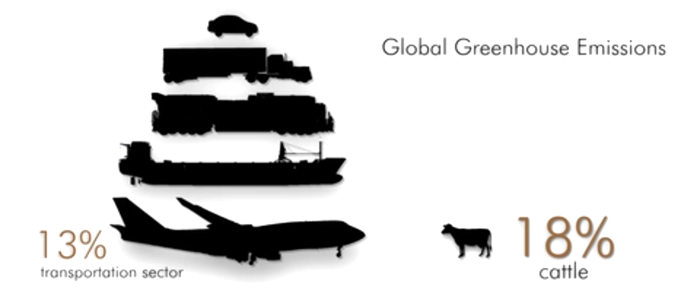The Link Between Animal Agriculture & Climate Change

Animal Agriculture is the #1 Contributor to Global Anthropogenic (or Human-Induced) Greenhouse Gas Emissions
In 2009, Robert Goodland and Jeff Anhang, two environmental specialists employed by two United Nations specialized agencies, the World Bank and International Finance Corporation, developed a widely-cited assessment titled, “Livestock and Climate Change: What if the key factors in climate change are… cows, pigs, and chickens?“. The report focuses on the 25,048 million tons of CO2e (or Carbon Dioxide Equivalent) attributable to livestock that have been undercounted or overlooked in other reports.
The report shows that livestock farming is responsible for at least 51% of global anthropogenic greenhouse gas emissions, instead of a mere 18% reported by the FAO (the United Nations Food and Agriculture Organization).
It implies that “replacing livestock products with better alternatives would be the best strategy for reversing climate change. In fact, this approach would have far more rapid effects on greenhouse gas emissions and their atmospheric concentrations – and thus on the rate the climate is warming – than actions to replace fossil fuels with renewable energy”.
Even if you were to reject this assessment in favor of the FAO report who found that livestock farming is attributable to 18% of global anthropogenic greenhouse gas emissions, that’s still more than the entire transportation sector which contributes only 13%. The image below as seen in the documentary, Cowspiracy, perfectly represents these statistics.

But, how exactly does animal agriculture contribute to global anthropogenic greenhouse gas emissions?
Breathing
Currently, there are more livestock animals than the entire human population. More than 8 billion livestock animals are exhaling carbon dioxide while earth’s capacity to store carbon dioxide is rapidly declining (e.g. deforestation). Goodland and Anhang estimate that livestock respiration contributes to 13.7% of global anthropogenic greenhouse gas emissions.
Land
Now that we’ve used up all of our natural grasslands to graze animals and grow their feed crops, we must resort to destroying natural forest. In fact, an acre of rainforest is cleared every second to produce more livestock and livestock feed. This video clip from Cowspiracy is a perfect representation of just how extreme this is:
Methane
The greenhouse gas methane warms the atmosphere much more strongly than carbon dioxide does because of its shorter half-life. The half-life of methane is only 8 years as opposed to 100 years for carbon dioxide. Much of the methane concentrations in our atmosphere are due to enteric fermentation in ruminant animals (e.g. cattle, buffalo, sheep, and goats) and waste management (e.g. anaerobic lagoons).
Enteric Fermentation
Enteric Fermentation refers to the fermentation of feed as part of the digestion process in ruminant animals. During this process methane is emitted from eructation or burping.
Waste Management
Anaerobic lagoons or manure lagoons are the most common way to treat livestock waste in animal agriculture. An anaerobic lagoon is “a man-made outdoor earthen basin filled with animal waste that undergoes anaerobic respiration as part of a system designed to manage and treat refuse created by Concentrated Animal Feeding Operations (CAFOs).” Ultimately, the manure will undergo a process called anaerobic respiration which will then emit both carbon dioxide and methane into the atmosphere.
This drone footage reveals just how awful these manure lagoons are for our environment and our health:
